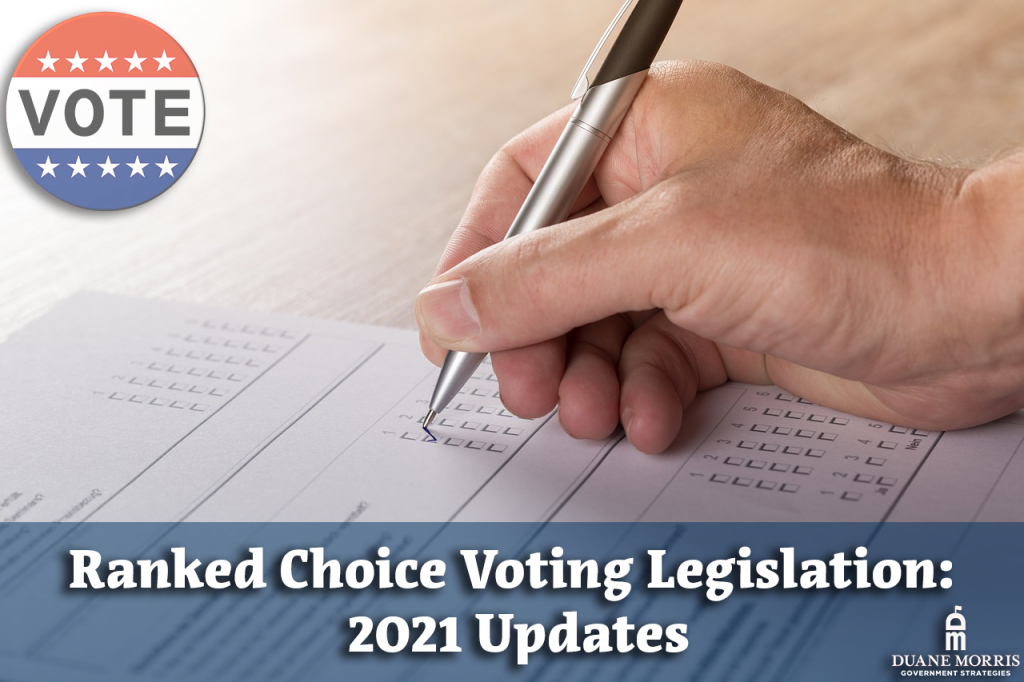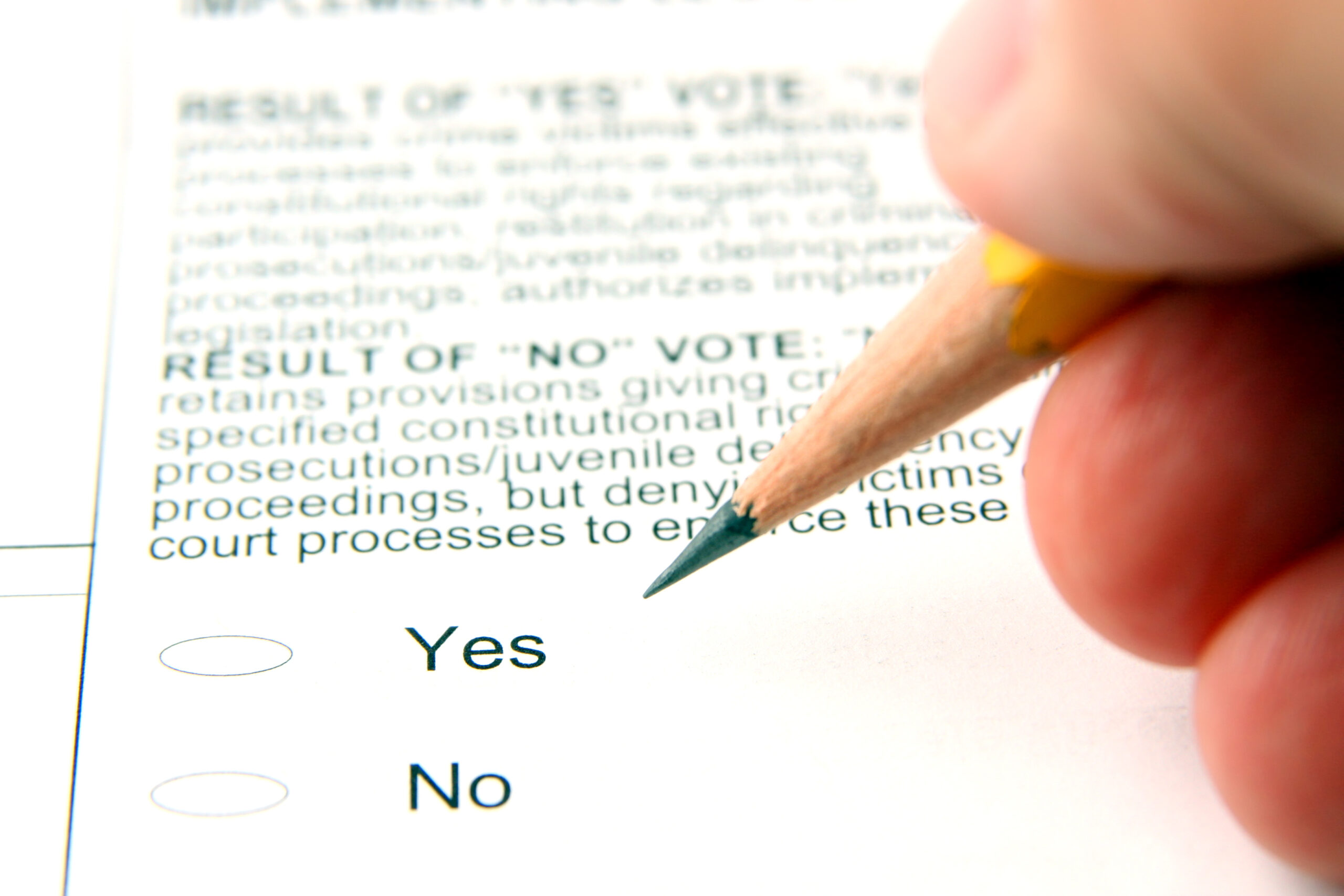
Last year, DMGS covered ranked choice voting and the states that either use the voting system or were looking to implement it via ranked choice voting legislation, or RCV legislation. Almost every state uses the same first-past-the-post voting system. In this winner-take-all method, voters can only choose one candidate per race on each ballot. Whoever receives the most votes wins, even if they do not have a majority of voters’ support. However, many other voting systems exist, including the increasingly popular ranked-choice voting.
In a ranked-choice voting system (RCV), voters rank candidates in order of preference: one, two, three, and so forth. Like in states with runoff elections, if no candidate reaches a 50% majority, the candidate with the lowest total votes is instantly eliminated. Under RCV, ballots are then instantly retabulated to reach a winner with a majority of voters’ support. Suppose a voter’s first pick is eliminated from the first round. In that case, their vote then goes to their second choice until one candidate reaches over 50%. If a voter’s vote cannot help their top choice win, their vote counts for their next choice.
Hawaii: RCV Legislation
Hawaii state lawmakers introduced numerous pieces of ranked choice voting legislation this year. SB 215 would allow RCV in state or county election contests held in partisan primary elections, special elections, and nonpartisan general elections. SB 215 would not apply to any elections held before January 1, 2022.
SB 169 would require any federal election not held on the date of a regularly scheduled primary election or general election and any special election for a vacant seat on a county council to be conducted via RCV.
SB 560 received the most attention this session. The bill passed both the Senate and House separately but did not end up advancing. SB 560 would, similar to SB 169, require any federal election not held on the date of a regularly scheduled primary or general election and any special election for a vacant seat on a county council to be conducted via RCV.
Illinois: Ranked Choice Voting Bills Stalled
Illinois lawmakers have introduced at least two pieces of ranked choice voting legislation in 2021. SB 1785 and HB 2416 would allow for RCV elections by candidates for the general assembly, governor, lieutenant governor, attorney general, secretary of state, comptroller, and treasurer.
The Illinois Neither bill has advanced yet.
Maine: Expanding Ranked Choice Voting Legislation
DMGS previously noted that Maine is the only state to establish RCV for all federal elections. However, at least two pieces of legislation introduced in Maine this year would further address ranked choice voting.
LD 859 would expand RCV to municipal elections and is a concept draft, which only contains a summary of the bill and not a fully drafted piece of legislation.
LD 202 would also amend the state’s Constitution to expand Maine’s use of RCV. Presently, candidates for governor, state senate, and state house are elected by a plurality of the votes cast. LD 202 would require those candidates to be elected by a majority of the votes cast.
Amending Maine’s Constitution would require two-thirds approval in both legislative chambers and then be submitted to voters for a referendum in the next general election.
Maryland: RCV Legislation Died
While Maryland’s 2021 legislative session has concluded, ranked choice voting legislation was introduced. House Bill 767, which died when the session ended, would have allowed the Montgomery County Council to adopt RCV or an approval voting system for elections for county executive, members of the county council, judge of the circuit court, State’s Attorney, clerk of the circuit court, register of wills, judge of the orphans’ court, sheriff, or member of the board of education.
Under the bill, the local law would provide for the ballot format, procedures for tabulating votes, and any other provision necessary to implement the new voting systems. The bill defined “ranked choice voting” as a method of casting and tabulating votes in which voters rank candidates in order of preference, and votes are tabulated in a manner that reflects voter preference. “Approval voting” was further defined as a method of casting and tabulating votes in which voters may choose any number of candidates and the candidate chosen most often is elected.
New Mexico Ranked Choice Voting: Next Session?
SJR 22 would amend the New Mexico Constitution to address ranked choice voting. Specifically, the amendment would require the legislature to provide RCV in all nonpartisan elections and all local elections and enable RCV for all partisan elections. SJR 22 failed to advance this session, stalling after a 5-5 tie vote in the Senate Rules Committee. Lawmakers supportive of the issue are hoping to continue their discussions into the next session.
West Virginia: RCV Legislation For Justices of the Supreme Court
Senate Bill 229 was introduced by West Virginia state lawmakers in early February. The bill would implement ranked choice voting for Justices of the Supreme Court of Appeals beginning with the 2024 election year.
Under the bill, in any contest conducted by RCV with three or more qualified candidates, a ballot would allow voters to rank candidates in order of choice. All RCV elections for one office would see tabulation proceeding in rounds. Each round would proceed sequentially as follows:
- Each ballot shall count as one vote for the highest-ranked continuing candidate on that ballot. If two or fewer continuing candidates remain, the candidate with the fewest votes is defeated. The candidate with the greatest number of votes is elected, and the tabulation is complete.
- If more than two continuing candidates remain, the continuing candidate with the fewest votes is defeated. A new round begins.
If a contest for greater than one office conducted by RCV, tabulation would also proceed in rounds under the bill. Suppose the number of continuing candidates is less than or equal to the number of offices to be elected in the initial tabulation. In that case, all continuing candidates are elected, and tabulation is complete. Otherwise, each round of tabulation would proceed sequentially as follows:
- Each ballot shall count at its current transfer value for the highest-ranked continuing candidate on that ballot. Suppose the sum of the number of elected candidates and the number of continuing candidates is equal to the sum of one and the number of offices to be elected. In that case, the candidate with the fewest votes is defeated. All the other continuing candidates are elected, and the tabulation is finished.
- Suppose at least one continuing candidate has more votes than the election threshold for the contest. In that case, each such candidate is elected. Each ballot counting for an elected candidate is assigned a new transfer value by multiplying the ballot’s current transfer value by the surplus fraction for the elected candidate, rounded down four decimal places, and ignoring any reminder.
The bill defines “continuing candidate” as any candidate that has not been defeated or elected and “transfer value” as the proportion of a vote that a ballot will contribute to its highest ranking candidate, where each ballot begins with a transfer value of one. If a ballot contributes to the election of a candidate, it will receive a new transfer value.
Latest News
Photo credit: iStock.com/rarrarorro The 2025 Pennsylvania primary election results are in. From Pittsburgh’s tightly contested mayoral race to Harrisburg’s crowded Democratic primary and key judicial contests across the state, voters made their voices heard. Meanwhile, [...]
Photo credit: iStock.com/burcu demir The 2024 election brought a major shift in the political landscape, with Republicans making sweeping gains across the country. Former President Donald Trump returned to the White House, winning both the [...]
Photo credit: iStock.com/Svanblar In the 2024 U.S. general elections, voters nationwide will make crucial decisions on 2024 ballot measures alongside selecting their political representatives. These ballot measures allow citizens to directly vote on policy issues [...]
Ever wondered what goes into organizing a U.S. presidential debate? In this episode of Back in Session, Ryan Stevens and Ryan DeMara sit down with Jean Cantrell and Dan Felton, who have served as members of [...]






Stay In Touch